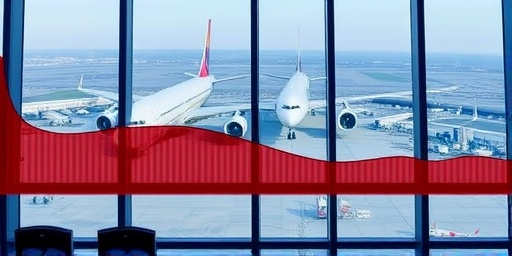Amid the escalating federal government shutdown, now in its third week, thousands of flights across the United States are facing delays and cancellations, crippling air travel and sending shockwaves through the economy. The Federal Aviation Administration (FAA) warns that understaffed air traffic controllers, many working without pay, are pushing the nation’s skies to the breaking point, with over 10,000 delays reported in the past 48 hours alone.
- Underpaid Heroes on the Brink: Air Traffic Controllers Grapple with Shutdown Strain
- Airlines Scramble: Cancellations Mount and Passenger Frustrations Boil Over
- Economic Fallout: Shutdown’s Shadow Over Travel-Dependent Sectors
- FAA Sounds Alarm: Calls for Bipartisan Action to Avert Aviation Crisis
- Looking to the Horizon: Pathways to Resume Normal Air Traffic Operations
Underpaid Heroes on the Brink: Air Traffic Controllers Grapple with Shutdown Strain
The backbone of America’s aviation system, air traffic controllers, are bearing the brunt of the government shutdown. Essential workers at the FAA have been mandated to report for duty despite the funding freeze, but without paychecks, morale is plummeting and overtime is scarce. According to the National Air Traffic Controllers Association (NATCA), more than 20,000 FAA employees, including controllers, are affected, leading to mandatory overtime and sick leave burnout.
“Our members are showing up every day to keep the flying public safe, but they’re exhausted and unpaid,” said NATCA President Paul Rinaldi in a recent statement. “This shutdown isn’t just inconvenient; it’s dangerous.” Data from FlightAware, a leading flight tracking service, indicates that Flight delays have spiked by 25% compared to the same period last year, with major hubs like Atlanta’s Hartsfield-Jackson International Airport seeing average delays of over 90 minutes per flight.
The situation echoes the 2018-2019 shutdown, the longest in U.S. history, when similar issues led to a 15% increase in air traffic incidents. Controllers manage everything from takeoff clearances to collision avoidance, and with staffing levels dipping below 85% capacity in key facilities, errors could prove catastrophic. The FAA has resorted to implementing traffic management programs, such as ground stops at busy airports, to mitigate risks, but these measures only exacerbate delays.
Real-World Impacts at Major Airports
- New York Area Airports: LaGuardia and JFK have reported over 500 cancellations since the shutdown began, stranding tens of thousands of passengers.
- Chicago’s O’Hare: Delays averaging two hours have disrupted Midwest business travel, affecting industries from manufacturing to finance.
- Los Angeles International: West Coast flights are bottlenecked, with air traffic congestion spilling over into international routes.
Experts warn that prolonged shortages could lead to a domino effect, where minor delays cascade into system-wide gridlock. “Air traffic control is like the circulatory system of aviation; when it’s clogged, everything slows down,” noted aviation analyst Henry Harteveldt of Atmosphere Research Group.
Airlines Scramble: Cancellations Mount and Passenger Frustrations Boil Over
Major U.S. airlines are reeling from the Flight delays, with carriers like Delta, American, and United issuing apologies and vouchers in a desperate bid to placate irate customers. Delta Air Lines reported canceling 300 flights on a single day last week, citing air traffic constraints as the primary culprit. The ripple effects are felt far beyond the tarmac: perishable goods shipments are rotting in cargo holds, and business meetings are derailed, costing companies millions.
Passenger stories highlight the human toll. Sarah Jenkins, a marketing executive from Boston, shared her ordeal on social media: “My flight from Logan to Dallas was delayed six hours due to air traffic issues from the shutdown. I missed my client’s pitch—irreplaceable time lost.” Similar anecdotes flood platforms like Twitter, with #ShutdownDelays trending nationwide.
The Airlines for America trade group estimates that Flight delays are siphoning $100 million daily from the industry, a figure compounded by the government shutdown’s broader economic drag. Refund policies are under scrutiny too; while the Department of Transportation mandates compensation for controllable delays, many airlines are classifying these as weather-related or staffing issues to avoid payouts. This has sparked lawsuits, with consumer advocates calling for federal intervention.
In a bid to cope, airlines are rescheduling routes and offering rebooking incentives, but with air traffic bottlenecks persisting, options are limited. Southwest Airlines, known for its point-to-point model, has been hit hardest in the Southwest, where regional airports lack the buffers of larger hubs.
Economic Fallout: Shutdown’s Shadow Over Travel-Dependent Sectors
The government shutdown’s assault on air traffic is not isolated to aviation; it’s throttling the U.S. economy at large. Travel and tourism, which contribute over $1.5 trillion annually to GDP, are hemorrhaging jobs and revenue. The U.S. Travel Association projects losses exceeding $5 billion from flight delays alone if the shutdown extends into next month, with small businesses in hospitality and logistics suffering disproportionately.
Consider the supply chain: Fresh produce from California farms is delayed en route to East Coast markets, driving up grocery prices and wasting inventory. E-commerce giants like Amazon report slower delivery times for air-freighted goods, impacting holiday sales projections. A report from the Brookings Institution highlights that every day of shutdown delays equates to $200 million in lost economic output, factoring in reduced consumer spending and business productivity.
“This is a self-inflicted wound on our economy,” remarked economist Dr. Elena Ramirez during a CNN interview. “Air traffic disruptions amplify the shutdown’s pain, hitting everything from tourism hotspots like Orlando to Wall Street commuters.” Unemployment claims in travel-related fields have surged 12% in shutdown-affected states, per Labor Department data.
Broader implications touch international trade too. Foreign investors are wary of U.S. instability, with airline stock prices dipping 5-7% across the board. The FAA’s role in certifying new aircraft and routes is also stalled, delaying innovation in a competitive global market dominated by players like Europe’s Airbus.
Sector-Specific Hits from Flight Delays
- Tourism and Leisure: Family vacations are upended, with Disney World reporting a 20% drop in bookings tied to travel woes.
- Business Travel: Conferences in Las Vegas and tech summits in San Francisco are sparsely attended, costing organizers millions.
- Cargo and Logistics: Overnight shipments are delayed by days, straining just-in-time inventory models for retailers.
- Healthcare: Medical supply flights are rerouted, potentially delaying critical treatments in remote areas.
The interplay between the government shutdown and air traffic woes underscores a vulnerability in America’s infrastructure. Federal funding for FAA modernization, including NextGen technology upgrades, is frozen, leaving outdated systems prone to overload.
FAA Sounds Alarm: Calls for Bipartisan Action to Avert Aviation Crisis
The FAA has ramped up its advocacy, with Acting Administrator Daniel Elwell testifying before Congress: “We cannot sustain this level of operations without additional resources. Flight delays are just the tip of the iceberg.” The agency has requested emergency appropriations to cover controller pay and hiring, but partisan gridlock in Washington shows no signs of abating.
Behind the scenes, contingency plans are in play. The FAA is prioritizing high-density corridors and exploring voluntary reductions in flight schedules, but these band-aids can’t heal the systemic issues. International partners, including the International Civil Aviation Organization, have expressed concern over U.S. airspace reliability, potentially affecting bilateral agreements.
Public pressure is mounting, with petitions garnering over 100,000 signatures urging lawmakers to end the shutdown. Bipartisan voices, from Senate Majority Leader Mitch McConnell to House Speaker Nancy Pelosi, have acknowledged the air traffic crisis, yet negotiations stall over unrelated budget disputes.
Innovative solutions are emerging from the private sector. Tech firms are piloting AI-assisted traffic management tools to alleviate controller burdens, but regulatory approval from the FAA is bottlenecked by the shutdown. Veteran pilots, speaking anonymously, warn of fatigue among crews juggling delayed schedules, adding another layer of safety risk.
Looking to the Horizon: Pathways to Resume Normal Air Traffic Operations
As the government shutdown drags on, the path forward hinges on congressional compromise. Optimists point to short-term funding bills as a lifeline, potentially restoring paychecks and easing air traffic strains within weeks. However, if unresolved, experts predict a summer travel meltdown, with flight delays becoming the new normal and economic scars deepening.
The FAA is preparing scenarios for extended disruptions, including enhanced collaboration with airlines for demand management and public awareness campaigns to adjust travel expectations. Long-term, this crisis could catalyze reforms, such as insulating FAA funding from budget battles to safeguard air traffic integrity.
Stakeholders urge vigilance: Travelers should monitor apps like FlightAware for real-time updates, while businesses pivot to virtual meetings to mitigate losses. Ultimately, resolving the shutdown isn’t just about politics—it’s about keeping America’s skies open and its economy aloft. With negotiations set to resume next week, all eyes are on Washington for signs of relief from the mounting flight delays.









